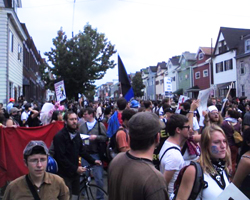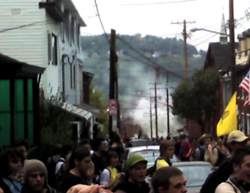Posted September 30, 2009
I drove from Tennessee to Pittsburgh for the G-20 events with a group of seven folks from Knoxville and Murfreesboro, including five Solidarity members (myself and Karen and Leslie P. from Knoxville, Jase S. and Colin R. from Murfreesboro) and two other comrades. We arrived very early Thursday morning and so were in town for all the major events on Thursday and Friday. A Catholic church was kind enough to provide housing for us, but not many people showed up to sleep there because of a rumor the place was going to get raided (it didn’t but a number of other safehouses did).

The major event on Thursday was an unpermitted march organized by the Pittsburgh G-20 Resistance Project (an anarchist group) starting in a park in Lawrenceville, a major Pittsburgh neighborhood, intending to go as far as possible toward downtown and the convention center. My estimate of the size of crowd at the park was 1,000 but I’ve heard other estimates as high as 2,000—either way, well under half the size of the total crowd at Friday’s permitted march and clearly consisting of the more radical and confrontational elements. I was interviewed by the New York Times and a friend from Knoxville was interviewed by the Pittsburgh Post-Gazette, the city’s major newspaper—his comments appeared in the next day’s paper but I still haven’t found out if the Times used anything from my interview.
A line of riot cops half-heartedly tried to block the park’s main entrance, but we simply exited via the other side. It was only about fifteen minutes and maybe a half dozen blocks into the march when we encountered a much larger group of riot cops with armored vehicles and sonic weapons. A mechanical voice, occasionally interrupted by blasts from LRAD sonic weapons, declared our assembly unlawful, ordered us to disperse, and threatened arrests, riot control agents, and “less lethal munitions” (rubber bullets). The bulk of the crowd moved down a side street, in which we were again met by police who, provoked by nothing more than rhythmic chanting, deployed several tear gas grenades, which exploded close enough to our crew that we were exposed to the gas.

Some black bloc anarchists retaliated by launching a dumpster on wheels at the armored vehicle carrying the mounted LRAD (it missed), but the crowd was forced to disperse and got split up into several smaller groups—I don’t know how big the others were but the one we were in had around 200 people. It was a member of this smaller group, one of the black bloc, who pulled out a hammer and smashed in a glass door and two external ATM machines at a PNC bank while we were marching, to the tune of boos and loud discouragement from the rest of the crowd. This was the sole example of property destruction by a protestor during either of the daytime mass marches and there were no incidents of harm or attempted harm to any person, police included. Most stories in mainstream media, of course, mentioned this incident before mentioning the use of tear gas and other forms of police violence, implying wrongly that they happened in that order. I’ve heard a lot of speculation that the person who smashed up the bank was some kind of undercover provocateur trying to damage our portrayal in the media—I’ve seen no actual evidence either for or against this claim, but if it’s true the attempt was certainly successful.
Soon after that incident, our group was ambushed by riot cops with unmuzzled dogs, transported largely in unmarked civilian vehicles and following in the wake of an ambulance that was apparently used just to clear the streets for the cops. That was the end of our splinter march, and I think similar things happened to the other groups, because shortly afterwards, there was a rendezvous of the whole march, smaller in number by this point, at a different park. The subsequent attempt to march toward downtown again was broken up just as quickly as the first attempt, this time with a number of protestors being encircled and beaten, and some being arrested. As far as I know there was no further marching during daylight on Thursday after that.
The mobilization on University of Pittsburgh campus Thursday night was even more violent on both sides, with over a dozen businesses suffering broken windows and many protesters being gassed, beaten, and arrested. There was a repeat Friday night, but even worse this time around. Many Pitt students who were just standing outside their dorms wondering what was going on were victims of police violence, including tear gas, pepper spray, batons, forceful arrests, and I think rubber bullets. Much of this was captured on videos which are available on YouTube and the PGH Indymedia website. The New York Times reported 50 arrests for the week in a Friday morning article, and I have since heard there were 200+ arrests total. Some of these arrests were non-protesting students, legal observers, and journalists. At least one journalist was beaten and had his film smashed up.

In contrast to all this, the Friday daytime march (The People’s March, sponsored by the Thomas Merton Center among many other groups) was permitted and peaceful throughout, despite the presence of several thousand police, ATF agents, and National Guardsmen stationed menacingly alongside the entirety of the route of an obviously peaceful crowd–although, notably, the cops and intimidation completely disappeared once we crossed the bridge and entered a low-income neighborhood, the safety of which is apparently not a concern. At the beginning of the march, I was very discouraged at a turnout which appeared to be between one and two thousand people, but it seemed to grow substantially until the march reached its first rally location, at which point we were estimating more like 5,000. Mainstream media have been reporting 10,000 people, which seems too high, but if that’s the number that goes down in the records, maybe we shouldn’t complain!
Still, the turnout to all of the events was disappointing if not surprising. Five to ten thousand may count as a victory in context, but the fact that the global justice movement is weak enough in the US that it can’t even pull a five-figure turnout to its largest event in four or five years is a depressing reality. We obviously need something new. Whether the events in Pittsburgh will turn out to be an impetus toward building anything greater I don’t know, but I think the media coverage they received can at least be helpful to our organizing. Despite some glaring inaccuracies of reporting, my impression is that most of the people who paid enough attention to get anything at all from the coverage got the message that police went way too far and attacked students, which hopefully sends a strong message about the oppression and authoritarianism surrounding the institutions we were protesting.
This is obviously not going to create any broad consciousness among the general public, but it seems to have had a major impact on quite a lot of folks I know whom I’d describe as semi-political, folks who seem shocked that this is the way our government responds to peaceful protest. Even in some activist circles in Tennessee, people who hadn’t even heard of the G-20 a few months ago and knew little about the global justice movement are now discussing and thinking about these issues. I hope this impact is more widespread than just my own anecdotal experience. In any case I think we have a responsibility to share these stories, and particularly some of the more disturbing videos, with as many people as we can. If it can serve as a wake up call to even a few people who might not otherwise be politicized, then at least something has been accomplished. That said, my overall feeling about the resistance is one of disappointment, and while possible it seems unlikely that this will have the impact I hoped it would in revitalizing surviving elements of the global justice movement.
